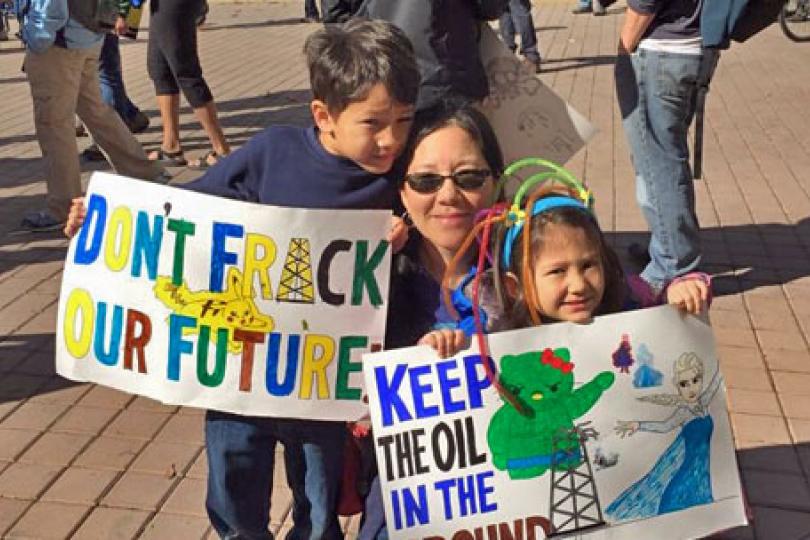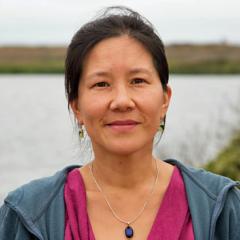Exposing the Hidden Dangers of Fracking
When you ask Switzer Fellow Sue Chiang (2007) about what drives her passion to expose the hidden dangers of fracking, her answer is straight and to the point.
“We’re looking at a new California Gold Rush, only this time the frenzy is nationwide, and now we have technology that’s capable of leaving an environmental footprint exponentially more harmful than what was possible in the past," says Chiang.
Chiang is especially alarmed by the fracking industry’s reckless expansion with almost no regulation. "Most people don’t realize that fracking has been unjustifiably exempted from virtually all federal environmental rules, with little analysis of the potential effects that the technology might have on human health, the environment, and our climate," she says. According to an analysis by the Wall Street Journal, there are over 1.1 million active oil and gas wells in the U.S., and as of late 2013, more than 15 million Americans now live within a mile of the hundreds of thousands of wells that have been drilled since 2000.
Chiang traces her interest in this work back to her first viewing of the film Gasland, which exposed the ongoing suffering of people living near fracking operations. She was appalled by what she saw, and she started thinking about the lifecycle of fossil fuels and the wide range of potential health problems facing people exposed to toxic pollution throughout the entire development process, from the beginning of oil and gas exploration through extraction and to distribution and use. At that time, Chiang was leading the Safer Electronics work at the Center for Environmental Health (CEH) in Oakland, California, to increase awareness and mitigate the harmful effects from toxic chemicals in electronics throughout their lifecycle. As part of that work, she collaborated with leading businesses to help shift their corporate purchasing towards more environmentally sustainable products and practices in the Information Technology sector. As Chiang describes it, she had an epiphany, “I thought, ‘What if I could use the connections and experience I have with green purchasing to direct businesses away from unsustainable energy use and into cleaner, healthier energy choices? Wouldn’t that be terrific?’”
As a Switzer Fellow, Chiang had received support through the Foundation for her work in the past. She approached the Foundation again to see if they would consider another grant to help her with this audacious but exciting idea – to shift her career focus from electronics to fracking. “I knew that I would have a lot of learning to do and in a very short timeframe. Our team at CEH had just gone through a strategic planning process, and I had helped advocate for a new focus on the health effects of fracking. Everything was lining up for this change in my work, but I was still nervous about what the Foundation might think about what was a pretty dramatic professional shift.”
Sue submitted a Concept Letter to the Foundation and was thrilled when she was invited to submit a full proposal for her plan. The proposal outlined a robust set of deliverables tied both to her proposed work and to her professional development. “The Foundation was very clear that they wanted my scope of work to encompass not just my project goals but also my career goals as well. I included professional development training as part of my plan, and I was especially excited when our proposal was approved that I would have the opportunity to participate in the Rockwood Leadership Training program.”
With her Switzer Leadership Grant approved in late 2013, Chiang was able to launch into CEH’s Healthy Energy campaign at the start of 2014. The campaign was primarily based in CEH’s New York office and laid out a four-pronged approach that included a combination of air monitoring work, scientific and grassroots organizing, maternal health studies, and a market campaign. Chiang's role was to spearhead the market campaign, and her first job was to learn as much as she could about the market landscape for natural gas. As she conducted her research, Chiang began to realize more and more the extent of the myth that industry had successfully promulgated about natural gas as a “clean, bridge” fuel that could help society transition to a renewable energy future. In reality, Chiang’s research was showing a wide range of environmental and health risks associated with the entire natural gas lifecycle.
During this period of exploration and growth, Chiang also began to discover that she would need more time and more resources to develop and build an effective market campaign. Moreover, she saw the immediate and timely potential of engaging with healthcare professionals as an under-utilized area of opportunity to advance her work. She made a strategic decision to shift the focus of her work from launching directly into a full-blown market campaign to building more targeted cultivation of professionals in the healthcare sector as messengers and advocates. Her idea was to leverage the credibility of health professionals to promote a discussion of the health effects of fracking and fossil fuels. Further, by engaging the healthcare institutions that these individuals represent, Chiang is planning to develop a longer-term market campaign focused on leading the healthcare sector toward renewable electricity. This strategy draws on the contacts and experience that Chiang and CEH have honed over many years through work with corporate and institutional purchasers in the healthcare field with a long-term goal to ensure energy sources and services that promote community health.
In December 2014, Governor Andrew Cuomo announced his historic and precedent-setting decision to ban fracking in New York. Two peer-reviewed studies led by CEH on the toxic and environmental health effects of fracking, and specifically on the adverse effects on pediatric and maternal health, were cited in the New York State Department of Health’s report that helped to inform the Governor’s decision. While California’s situation is quite different from New York, the Golden State is the next frontier for moving the discussion around fracking and oil and gas development toward a greater focus on public health. Accordingly, Chiang is taking CEH’s experience with multi-state air monitoring in New York and translating it into her campaign work in California. She is working with Global Community Monitor and pursuing a community-based air monitoring project that will involve training community members living in areas affected by fracking and other forms of oil and gas development to take air samples and collect data about the potential health risks from localized air pollution in at least three locations around the state. The data collected through this project will be critical in establishing a baseline of information specific to California. Coupled with the state’s groundbreaking law (SB4) that requires the disclosure of fracking chemicals, the data will serve as an especially powerful tool to encourage the state to move forward with a formal investigation of the health effects of fracking.
As Chiang looks to the future of her work, she is thinking strategically about the next steps in her campaign. Specifically she is considering how to integrate the broader message of climate change with her project’s focus on health professionals and how to connect with the variety of groups in the U.S. and internationally who are mobilizing health professionals around climate. She also reflects on how support from the Switzer Foundation helped bring her to this exciting inflection point in her career where she can use her experience, her skills, and her connections to help make a difference in the fight against fracking and oil development in California. “I’m so grateful for the Switzer Leadership Grant that helped me make this transition to a new program area – particularly one so complicated with a steep learning curve and a big potential reach – and emerge with a new direction and focus for my work. I want to leave a better world for my two children and all future generations, and thanks to support from the Switzer Foundation, I am getting a chance to do exactly that.”

